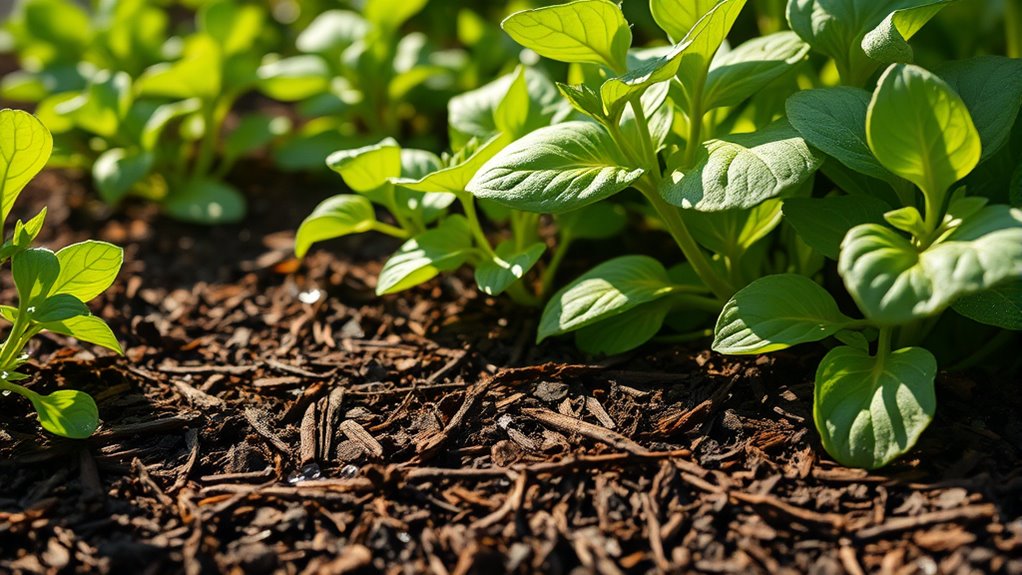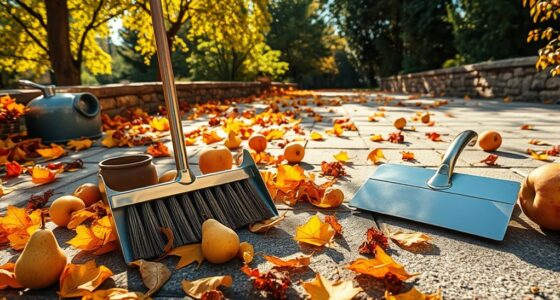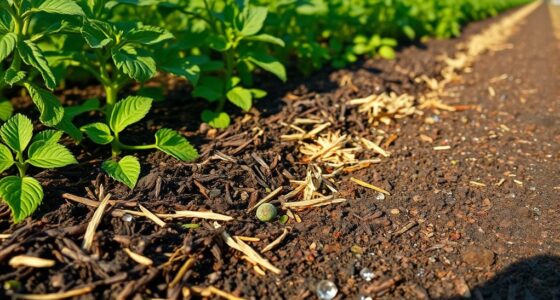Mulching helps reduce splash-borne diseases by creating a physical barrier that limits soil contact with plant foliage during rain or watering. It covers the ground, absorbing impact and preventing soil, which may carry pathogens, from splashing onto leaves. This simple practice considerably lowers the risk of soil-borne infections and keeps your plants healthier. If you want to know more about effective mulching tips and types, keep exploring how this method can protect your garden.
Key Takeaways
- Mulch acts as a physical barrier, preventing soil and water splash from reaching plant foliage during rain or watering.
- Applying mulch reduces soil disturbance, thereby decreasing the spread of soil-borne pathogens via splash.
- Organic mulches decompose to improve soil health, further strengthening plants against splash-borne diseases.
- Mulch evenly spread around plants lessens the force of water impact, minimizing pathogen transfer from soil to leaves.
- Proper mulch application keeps soil and plant surfaces dry, significantly lowering the risk of splash-borne disease transmission.

Have you ever noticed how water splashing onto plant leaves can spread soil-borne diseases? When rain or irrigation hits the soil surface, it creates splashes that carry pathogens from the ground onto healthy foliage. This simple event can lead to widespread infections, especially in densely planted gardens or fields. To combat this, mulching offers a practical solution. By covering the soil with a layer of organic or inorganic material, you create a physical barrier that minimizes the force of water hitting the soil, considerably reducing the splash effect. This not only helps keep soil-borne diseases at bay but also plays a vital role in weed control. Mulch suppresses weed germination by blocking sunlight from reaching weed seeds, making it harder for unwanted plants to establish themselves. As a result, you spend less time battling weeds and more time enjoying your garden.
Mulching reduces soil splash, prevents disease spread, and controls weeds for healthier plants.
Additionally, mulch improves moisture retention, which benefits your plants by maintaining a more consistent soil environment. When soil retains moisture better, plants experience less stress during dry spells, leading to healthier growth and increased resilience against diseases. Proper mulching reduces evaporation, so you don’t have to water as frequently, saving you time and effort. This moisture conservation also curbs the growth of weeds that thrive in dry, disturbed soil, further supporting weed control efforts. Furthermore, mulch can help regulate soil temperature, creating a more stable environment for root development and reducing stress on plants during extreme weather conditions.
Choosing the right mulch is key. Organic options like wood chips, straw, or shredded leaves decompose over time, enriching the soil with nutrients. Inorganic mulches, such as plastic or landscape fabric, provide long-lasting coverage and excellent weed suppression but don’t add organic matter. Whichever type you select, make sure it’s spread evenly around your plants, about two to three inches thick, to maximize its benefits. Be careful to keep mulch a few inches away from plant stems to prevent rot and pests.
Mulching acts as a multi-functional shield. It minimizes splash-borne disease spread, keeps weeds in check, and stabilizes soil moisture. These combined benefits create a healthier growing environment, making your gardening efforts more effective and less labor-intensive. By implementing mulch thoughtfully, you not only protect your plants from disease but also promote a more productive and manageable garden. It’s a simple, natural step that delivers meaningful results, helping you cultivate a thriving, disease-resistant landscape.
Frequently Asked Questions
Does Mulching Require Specific Types of Organic Materials?
You don’t need specific types of organic materials for mulching, but choosing the right kind matters. Organic mulches like straw, bark, or compost help reduce splash-borne disease effectively, while inorganic options like plastic or gravel don’t. Your choice depends on your garden’s needs. Organic mulches decompose over time, enriching the soil, whereas inorganic ones last longer but don’t provide nutrients. Select based on your garden goals and the type of mulch you prefer.
How Often Should Mulch Be Replaced or Replenished?
You should replenish your mulch as needed to keep it effective, usually every 1-2 years. Mulch longevity depends on material type and weather, so keep an eye out for signs of decomposition or weed growth. Don’t wait for problems to crop up; regular replenishment guarantees your garden stays healthy and pest-free. Think of it as giving your plants a fresh coat of armor to fend off disease and pests.
Can Mulching Be Used Effectively in All Climate Zones?
Yes, mulching can be effective in all climate zones if you choose the right mulch for your climate adaptation. You should select mulch based on your local conditions, such as moisture levels, temperature, and soil type. For example, organic mulch works well in humid areas, while inorganic options suit drier climates. Proper mulch selection guarantees benefits like moisture retention and disease reduction, regardless of your climate zone.
Are There Any Specific Mulch Colors That Affect Disease Prevention?
You’ll find that mulch color influence can play a role in disease suppression techniques. Darker mulches, like black, absorb heat and may help reduce fungal growth by creating less favorable conditions for pathogens. Conversely, lighter mulches reflect sunlight, potentially lowering soil temperature and moisture retention. While mulch color alone doesn’t prevent diseases, selecting appropriate mulch colors can complement other disease prevention strategies and improve overall plant health.
What Are the Potential Drawbacks or Risks of Mulching?
Mulching can cause soil compaction over time, which may restrict root growth and water movement. It might also attract pests like insects or rodents, especially if you use organic mulch that decomposes quickly. Additionally, improper mulching can lead to fungal diseases if moisture gets trapped against plant stems. Always apply mulch correctly, keep it away from plant bases, and monitor for pests to minimize these risks.
Conclusion
By applying mulch, you shield your plants from harmful splashes, reducing disease and promoting healthy growth. Yet, neglecting this simple step can leave your garden vulnerable to infections, turning lush greens into wilting shadows. It’s a quiet defense against chaos—a barrier that’s easy to overlook but essential. With mulch, you create a peaceful shield, contrasting the chaos of disease. Embrace this natural armor and watch your garden thrive, resilient and disease-free.









